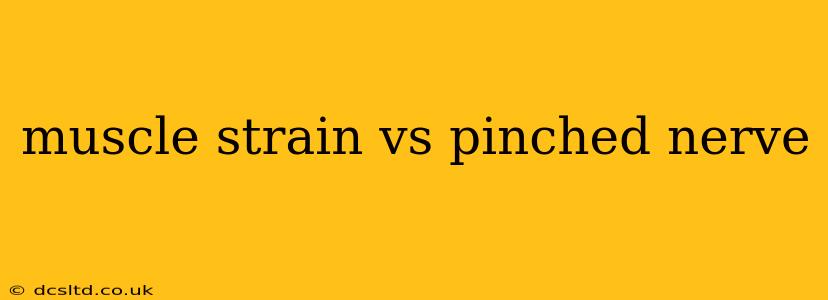Muscle strains and pinched nerves are common causes of pain and discomfort, often affecting the back, neck, and limbs. While both can result in similar symptoms, understanding their underlying causes and distinguishing features is crucial for proper diagnosis and treatment. This article will delve into the key differences between muscle strains and pinched nerves, addressing common questions and misconceptions.
What is a Muscle Strain?
A muscle strain, also known as a pulled muscle, occurs when muscle fibers are overstretched or torn. This typically happens due to sudden movements, overuse, or inadequate warming up before physical activity. The severity of a muscle strain can range from mild discomfort to a significant tear requiring medical intervention. Symptoms often include pain, swelling, bruising, muscle spasms, and limited range of motion in the affected area.
What is a Pinched Nerve?
A pinched nerve, or nerve compression, happens when a nerve is compressed or irritated, usually by surrounding tissues like bones, muscles, tendons, or ligaments. This compression can disrupt the nerve's ability to transmit signals, leading to pain, numbness, tingling, weakness, and other neurological symptoms. The location of the pinched nerve determines the affected body part and the type of symptoms experienced. For example, a pinched nerve in the neck (cervical radiculopathy) might cause arm pain and numbness, while a pinched nerve in the lower back (lumbar radiculopathy) might radiate pain down the leg (sciatica).
What are the Key Differences Between Muscle Strain and Pinched Nerve?
While overlapping symptoms can make differentiation challenging, several key distinctions exist:
- Cause: Muscle strains result from overexertion or injury to the muscle itself, while pinched nerves are caused by compression or irritation of the nerve by surrounding structures.
- Type of Pain: Muscle strain pain is typically localized to the affected muscle and feels achy or sore. Pinched nerve pain often radiates along the nerve's pathway, characterized by sharp, shooting, or burning sensations.
- Numbness and Tingling: Numbness and tingling are less common in muscle strains but are hallmark symptoms of a pinched nerve.
- Weakness: Muscle weakness is more associated with pinched nerves as the compressed nerve disrupts proper muscle function. While a severely strained muscle might exhibit some weakness, it's usually less pronounced than in nerve compression.
- Range of Motion: Both conditions can limit range of motion, but the nature of the limitation differs. Muscle strains often cause pain that restricts movement, while pinched nerves might cause pain with specific movements that aggravate the nerve.
What are the Symptoms of a Muscle Strain?
H2: What are the common symptoms of a muscle strain?
Common symptoms of a muscle strain include localized pain, tenderness to the touch in the affected muscle, muscle spasms, swelling, bruising, and limited range of motion. The severity of symptoms depends on the extent of the muscle damage.
What are the Symptoms of a Pinched Nerve?
H2: What are the common symptoms of a pinched nerve?
Common symptoms include pain that radiates along the nerve's path (e.g., sciatica), numbness, tingling, weakness in the affected area, and altered sensation (e.g., increased sensitivity to touch). The specific symptoms will depend on the location of the pinched nerve.
How are Muscle Strains and Pinched Nerves Diagnosed?
H2: How are muscle strains and pinched nerves diagnosed?
Diagnosis typically involves a physical examination, where the healthcare professional assesses range of motion, palpation (feeling for tenderness or muscle spasms), neurological testing (checking reflexes and sensation), and reviewing the patient's medical history. Imaging studies like X-rays (to rule out fractures) or MRIs (to visualize soft tissues, including nerves and muscles) might be necessary in cases of persistent or severe symptoms.
How are Muscle Strains and Pinched Nerves Treated?
H2: How are muscle strains and pinched nerves treated?
Treatment depends on the severity of the condition. Muscle strains often respond well to conservative management, including rest, ice, compression, elevation (RICE), over-the-counter pain relievers, and physical therapy to improve flexibility and strength. Pinched nerves might require a more tailored approach, which could involve medication (such as anti-inflammatory drugs or nerve pain medications), physical therapy, injections (such as corticosteroids), or in some cases, surgery.
Can a Muscle Strain Lead to a Pinched Nerve?
H2: Can a muscle strain lead to a pinched nerve?
While not always directly causative, a severe muscle spasm or inflammation from a muscle strain can potentially contribute to nerve compression, especially in areas where nerves run close to muscles. The muscle strain itself might not directly pinch the nerve, but the associated swelling and inflammation could create the pressure needed for nerve compression.
This information is for general knowledge and does not constitute medical advice. Always consult with a healthcare professional for accurate diagnosis and treatment of any medical condition. They can perform a proper evaluation and recommend the appropriate course of action based on your individual circumstances.
